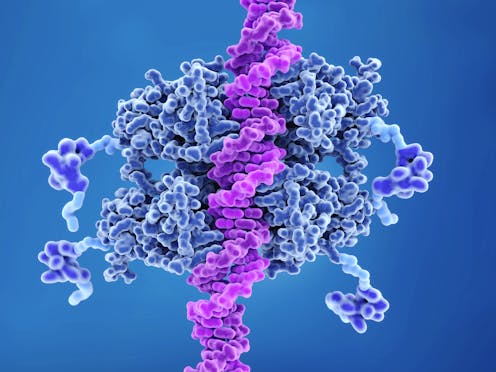p53 is both your genome’s guardian and weakness against cancer – scientists are trying to repair or replace it when it goes awry
- Written by Prosper Obed Chukwuemeka, Ph.D. Candidate in Integrative Systems Biology, University of Pittsburgh

Cancer arises when your cells grow uncontrollably and refuse to die[1] when they should. Normally, your body is equipped with regulatory processes to prevent this chaos. One such mechanism involves a protein called p53[2]. Often dubbed the “guardian of the genome[3],” this protein plays a pivotal role in ensuring that your cells grow, divide and die in an orderly fashion. When p53 malfunctions, the result is often cancer.
Learning about how p53 works has not only deepened how scientists understand cancer, but also provided promising avenues for new treatments.
In my work as a cancer researcher[4], I study the underlying mechanisms of how tumors develop and resist treatment. By understanding how cancer cells bypass safeguards like p53, scientists can find better ways to stop them, leading to more effective treatments for patients.
How p53 works
Each cell contains DNA that instructs it how to function. Over time, this instruction manual can accumulate errors[5] due to various factors like exposure to harmful ultraviolet rays, smoking or even just natural wear and tear.
This is where p53 comes in. It acts like a vigilant proofreader[6], detecting errors in DNA and deciding how to handle them. If the damage is minor, p53 instructs the cell to repair it. But if the damage is beyond repair, p53 triggers a process called apoptosis, or programmed cell death[7], ensuring the faulty cell doesn’t turn cancerous.
In more than half[8] of all human cancers, p53 is either missing or dysfunctional. This often happens when the gene that encodes for p53 is mutated or deleted. Without a functioning p53, errors in DNA go unchecked, allowing damaged cells to multiply and form tumors.
Targeting p53 pathways
Given its crucial role in preventing cancer, p53 has become a major target for drug development.
Over the years, scientists have devised various strategies to target the p53 pathway[11], or the network of molecules p53 controls to regulate cell growth, repair DNA damage and trigger cell death. Rather than acting alone, p53 interacts with multiple molecular pathways – some of which researchers are still discovering – that help determine a cell’s fate.
Treatment approaches aim to restore or mimic p53’s function in cells where it has gone awry. For example, scientists have developed small molecules that can bind to mutant p53 and stabilize its faulty structure, restoring its ability to bind DNA and regulate genes. Drugs like PRIMA-1[12] and MIRA-1[13] essentially “rescue” p53, allowing it to resume its role as the cell’s guardian.
Even when p53 is missing, scientists can still target the processes it normally controls to treat cancer. For example, drugs can activate apoptosis or halt cell division in ways that mimic p53’s normal function. Drugs like ABT-737[14] or Navitoclax[15] can block proteins in the p53 pathway that usually stop apoptosis, allowing cell death to occur even when p53 is absent.
Targeting p53’s overseers
Researchers are also investigating other proteins[16] that interact with p53 as potential treatment options. Because the p53 pathway is highly complex, targeting different parts of this network presents both opportunities and challenges.
My colleagues and I are studying two other closely related proteins that regulate p53 by marking it for destruction when it’s no longer needed. These proteins, called MDM2 and MDMX[17], become overactive in cancer and break down p53.
p53 is quickly activated to respond to DNA damage.Researchers have developed drugs to block MDM2 or MDMX, but targeting just one of these proteins is often not enough[18]. If one is blocked, the other can step in and continue to destroy p53. Most existing drugs are also much better at blocking MDM2 than MDMX[19] due to subtle differences in the latter’s shape, including a smaller area for p53 to bind. This makes it harder for drugs designed to target MDM2 to effectively bind to or reach MDMX.
To find molecules that could bind to both MDM2 and MDMX, researchers traditionally synthesize and test each molecule individually, which is often time-intensive and costly. In contrast, my colleagues and I used computer modeling tools[20] to simulate how thousands of molecules might interact with the proteins, allowing us to narrow down potential candidates much more quickly.
We identified a small molecule we called CPO[21] that shows promise in its ability to target both MDM2 and MDMX. Our models showed that CPO may have a stronger ability to block both MDM2 and MDMX than another molecule[22] that researchers previously found could inhibit both of these proteins in cell culture.
More research is needed to confirm whether CPO works in living systems the same way it does in our computer predictions. If CPO is as safe and effective in cell and animal models, it may offer another treatment option for cancers where MDM2 and MDMX are overactive.
p53 and cancer treatment
The journey to fully harnessing the p53 pathway for cancer therapeutics is ongoing, and researchers are exploring several promising options.
Advances in gene-editing technologies like CRISPR[23] are opening doors to directly correct p53 mutations in cancer cells.
Additionally, researchers are exploring combination therapies[24] that pair p53-targeting drugs with other treatments, such as immunotherapy, to amplify their effectiveness.
Like other cancer treatments, one major challenge is ensuring the drugs target p53 in cancer cells and spare healthy cells from unnecessary damage. Achieving this balance will be crucial in translating these therapies from the lab to the clinic.
References
- ^ refuse to die (www.youtube.com)
- ^ called p53 (www.nature.com)
- ^ guardian of the genome (doi.org)
- ^ cancer researcher (scholar.google.com)
- ^ accumulate errors (www.nature.com)
- ^ vigilant proofreader (www.nature.com)
- ^ apoptosis, or programmed cell death (theconversation.com)
- ^ more than half (www.cancer.gov)
- ^ David Goodsell/RCSB PDB-101 (pdb101.rcsb.org)
- ^ CC BY-SA (creativecommons.org)
- ^ p53 pathway (doi.org)
- ^ PRIMA-1 (doi.org)
- ^ MIRA-1 (doi.org)
- ^ ABT-737 (doi.org)
- ^ Navitoclax (www.cancer.gov)
- ^ investigating other proteins (doi.org)
- ^ MDM2 and MDMX (doi.org)
- ^ often not enough (doi.org)
- ^ better at blocking MDM2 than MDMX (doi.org)
- ^ used computer modeling tools (doi.org)
- ^ called CPO (doi.org)
- ^ another molecule (doi.org)
- ^ like CRISPR (theconversation.com)
- ^ combination therapies (doi.org)
Authors: Prosper Obed Chukwuemeka, Ph.D. Candidate in Integrative Systems Biology, University of Pittsburgh




